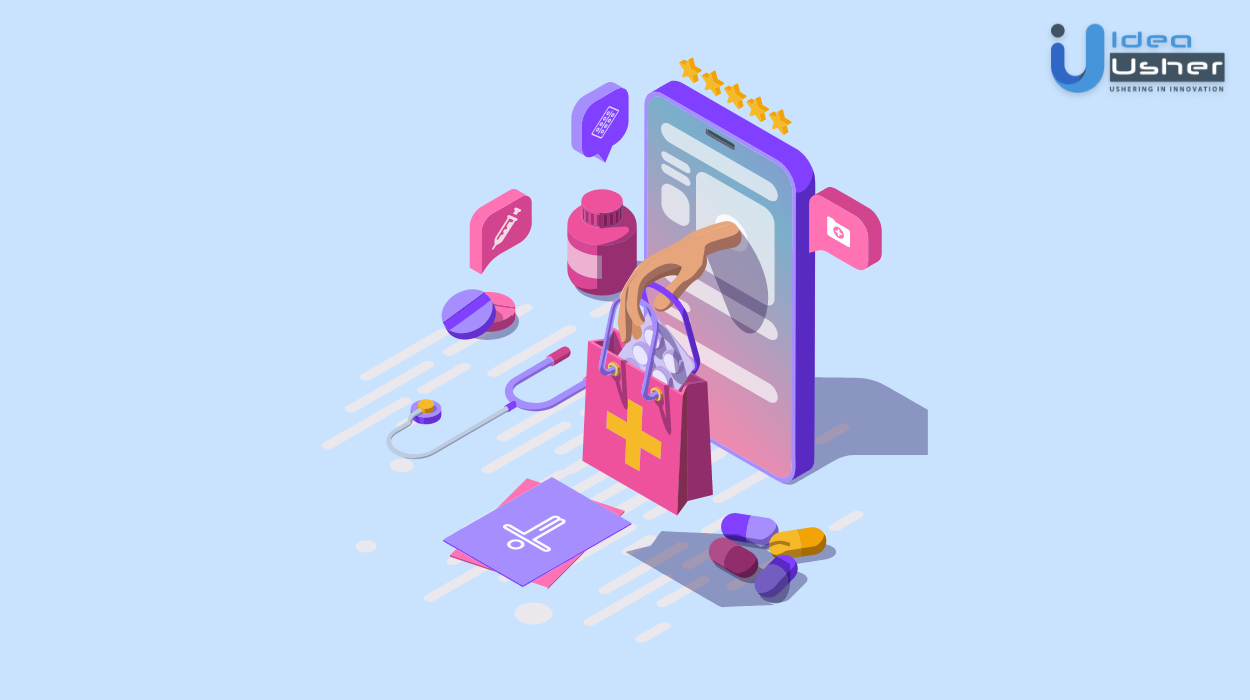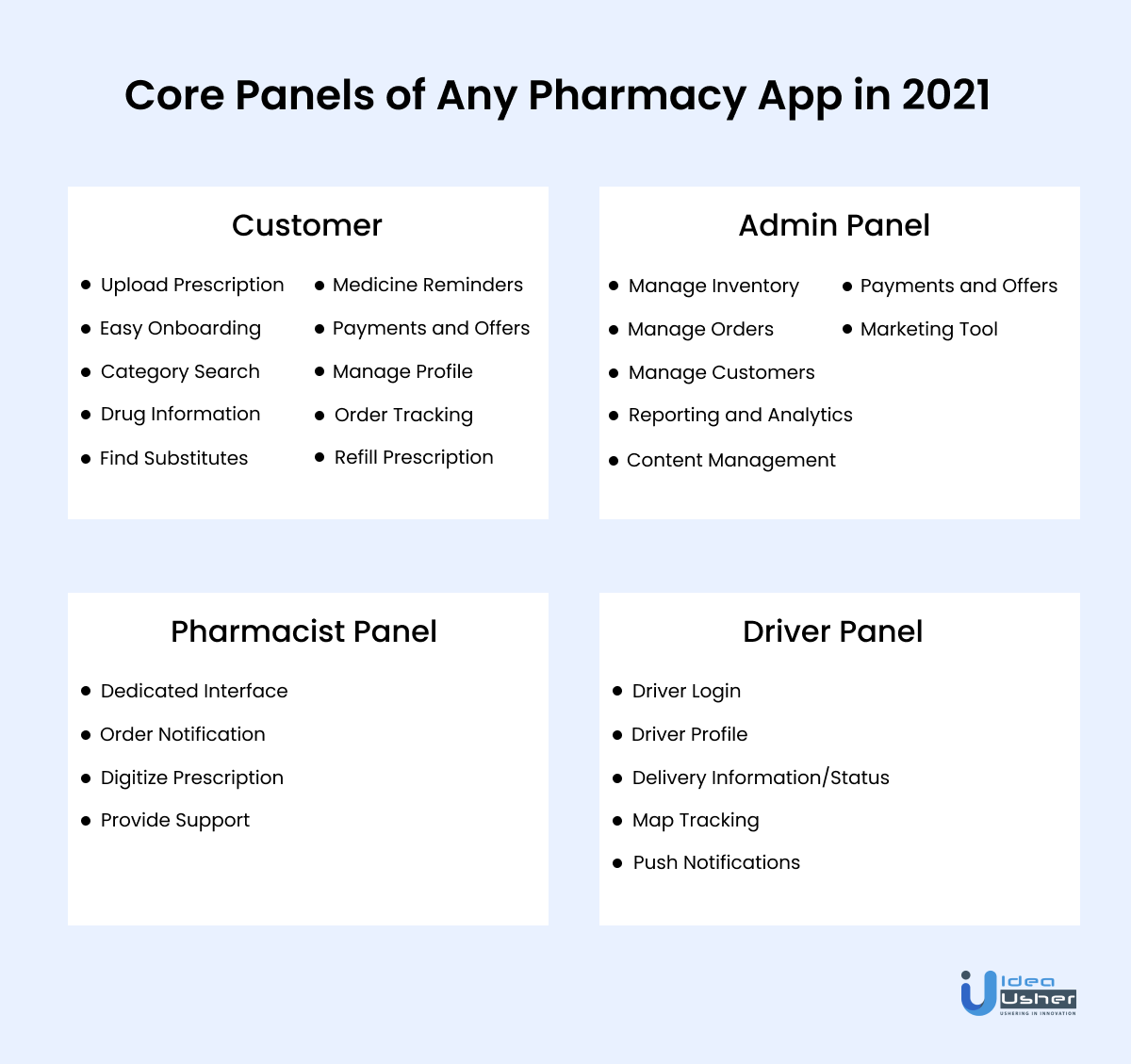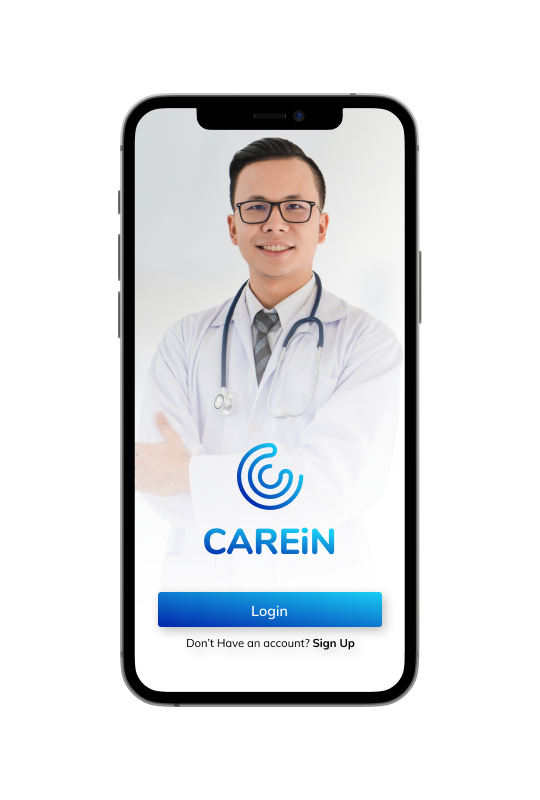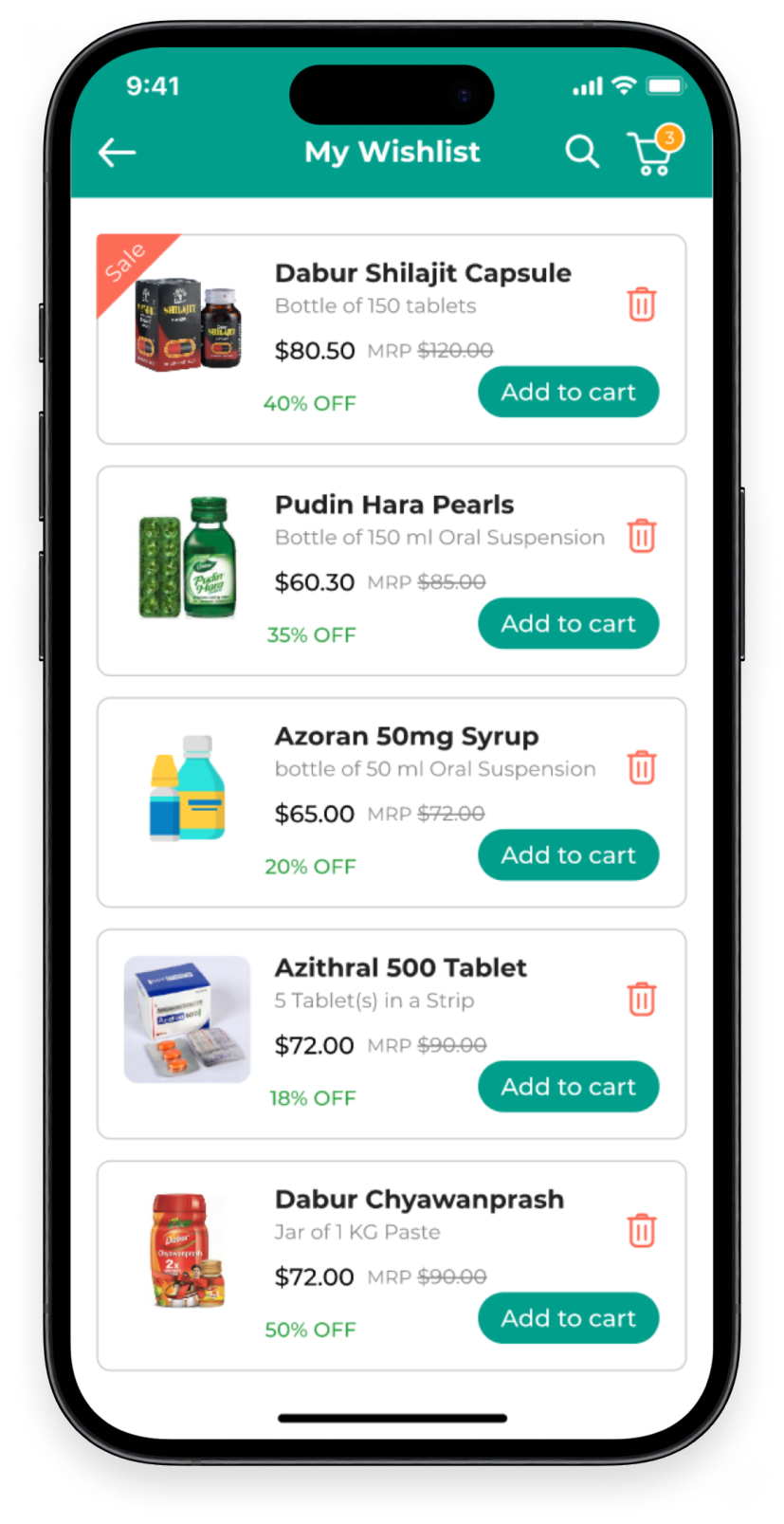The medicine delivery application market is still untapped. It has a lot to work on as of now. Security and privacy are a few reasons why people are hesitant to buy medicines online.
Even though most of us are comfortable staying at home for long periods, this is not what we had in mind when the COVID-19 pandemic began. It turns out that being confined to four walls is stressful too. The medicine delivery application is one of the most used apps in the wake of the situation.
Rollback a few years, and the idea of having medicines on your doorstep might sound quite weird. In 2021, various medicine delivery applications have registered multifold profits. The market space is now full of emerging delivery apps.
If you were wondering what the top 10 online medicine delivery applications are, we have covered them in a separate blog. Idea Usher has developed medicine delivery apps quite a few times in the past. So if you are thinking of making one, be sure to check us out! Our expertise might help you create the next Netmeds or 1mg.
According to a report by Zion Market, the global e-pharmacy market will reach $107 by the end of 2025. Even if the current pandemic ends, people will continue buying medicines online. Having said that, the future of medicine delivery apps looks bright.
Why are on-demand medicine delivery applications trending?
The COVID-19 pandemic has us all locked up in our homes. It is one of the major driving factors behind the sudden emergence of the medicine delivery app segment.
| Until now, people physically went to pharmacy stores to get a hold of their monthly or weekly descriptions. But things have changed quite drastically in the last year. |
With most of the population on our planet locked in the vicinity of their homes, people have no choice but to buy things online. And medicine is something most of us or someone we know take on an almost daily basis. Lockdowns in various parts of the world meant stores being shut for weeks and months straight.
While pharmacy stores reached out to customers, several fake medicines took over the market by storm. Thus, a lot of people looked for alternatives. The only option they could find was online pharmacy delivery apps like Netmeds.
How is the medicine delivery applications niche shaping the industry?
In 2018, mobile health apps were struggling so much that they did not record any profits. These apps generated just over $8 billion in the year. But, according to a report by Zion, the sector is witnessing rapid growth. By 2025, mHealth apps will record a revenue of about $111.1 billion. Prescription medicines form a formidable chunk of the total medical products sold online.
- Not only do these medicine home delivery services help you get your prescriptions on time, but they also help fight counterfeit ones.
- Many of these apps might restock directly from the companies, thus eliminating the risk of buying fake products.
- Moreover, such apps have a reputation to maintain, which might tarnish if they sell fake or low-quality products.
Effect of COVID-19 on the medicine and pharmacy industry
Before the pandemic made our movement severely restricted, the global e-pharmacy industry was still in its infancy. A lot of these apps were still struggling to make ends meet but are now thriving. The pharmaceutical companies are also trying to capitalize on the same. Instead of dealing with stores, they are now reaching out to online medicine stores to help them cut some costs here and there.
However, not everything is not as green as it seems. People responsible for home delivery will always be at a greater risk of infection. Since they are going places, it is highly likely they might contact someone infected. Then there is the supply shortage.
The COVID-19 pandemic has resulted in people panicking and hoarding medicines. They are storing stockpiles of drugs, fearing shortage. Even the United States president had to come out and tell people not to buy things like it’s the end of the world. All over the world, people are buying medicines in bulk.
Nonetheless, the pandemic has led to an overall increase in the revenue of these prescription delivery apps. This is because people don’t have to go to the store and check if they have the medicines they need. It looks like people like the idea of being able to buy drugs from a single window.
Business models – Medicine delivery applications
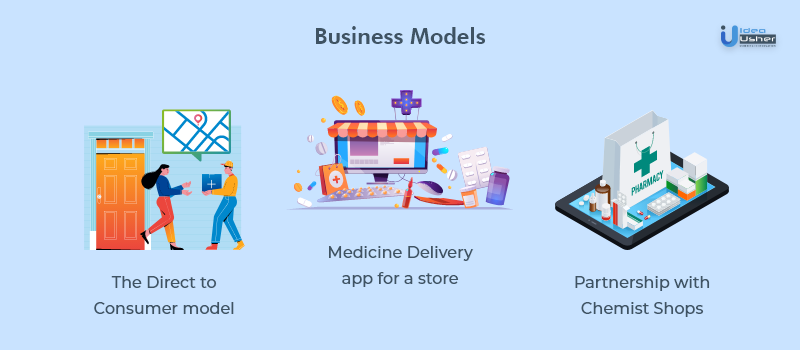
There are various Business models that these on-demand medicine delivery applications use. Let us see some of these in brief:
1. The direct-to-consumer model
The Direct to Consumer model works just the way you think you thought it would. Pharma companies have developed an online medicine store app that enables them to deal with customers directly. While it is not as popular as the other business models, some pharma companies have successfully implemented it.
This lets them avoid the cost associated with any middlemen, thereby helping them become profitable. It also helps them manage their supply chain efficiently. Although this is the ideal solution, it is not as efficient as it seems.
Not every pharma manufacturer makes a wide range of products. Thus, users will be limited to a few products and need to download a lot of apps. It is the reason why most medicine apps avoid this business model altogether.
2. Medicine delivery application for a store
It is one of the two operational models that a lot of the apps make use of. Customers are supposed to submit their prescriptions and place orders with retailers online. After the prescription is submitted, the retailer then checks if the medicine is available in their inventory. They then update the customer with a list of available products. The final step is the user paying for their order via the preferred payment gateway.
3. Partnership with chemist Shops
This is the most common business model adopted by the majority of pharma delivery apps. Unlike the other two models, it is a lot more flexible. It does not require a particular medicine to be in their inventory. Instead, they partner up with several local pharmacy shops in an area. So, when a user places an order, the nearest pharma store to the user checks if they have the product. In case they don’t, the request is diverted to the next closest store.
In this business model, both parties must sign an agreement. After that, they can work with each other.
Monetization methods used by various medicine delivery applications
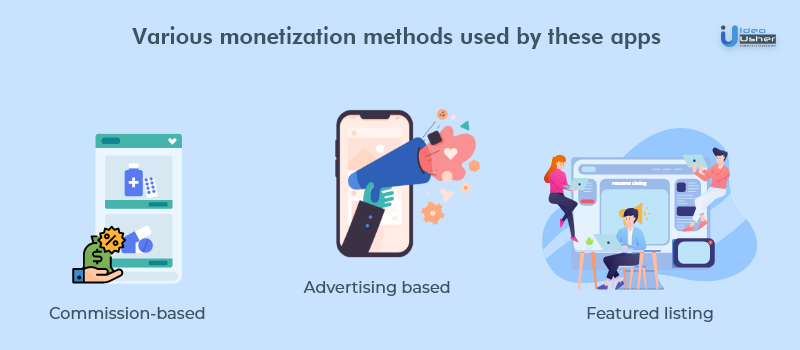
Ever thought of how online medical store apps pay their bills and earn income? Well, if you did, let us take a look at how they stay afloat. Basically, like all other apps and marketplaces, there are three significant ways these apps monetize their operations.
1. Commission-based
The commission-based model is the most popular of the three. Almost every app in this niche makes use of it in some way or the other. These on-demand medicine delivery apps offer a platform to all pharmaceutical companies looking to sell their products. They even enable the local stores to increase their overall sales and customer base.
In return, the app developers charge a commission fee on every sale they make. It can either be a percentage of the number of sales or depend on the medicines they sell using the platform. Either way, both pharma companies / local stores and app developers profit from this type of arrangement. This is why it is the most feasible and widely used monetization strategy.
2. Advertising based
This is another source of revenue for all online pharmacy delivery apps out there. Since users do not like to see advertisements in applications they spend money on, pharma apps have found a workaround. Instead of showing ads, they sell spaces for advertisements promoting:
- Other pharmaceutical companies
- Medical insurance companies
- Diagnostic labs
- Online wallets
- Pharma stores
- Hospitals bulletin boards
- Related products or brands
3. Featured listing
All medicine delivery apps are online marketplaces. So, it’s natural for them to engage in featured listings. It helps these apps earn some money and is a good source of generating additional revenue. The listings are usually visible as sponsored results in the search results or found in featured products.
Since medicine delivery is a mobile application, features are offered depending on the type of user.
1. Admin panel
Supply and user management
The administrator has a provision for managing incoming customer orders. The app administrator should easily manage various users, manufacturers, and suppliers who use the platform.
Analytics and reports
Extracting relevant data from the app database should be easy so the team can quickly come up with reports and present specific analytics.
Tracking profits
The admin panel should have the ability to quickly check the profits in a certain period, such as monthly, quarterly, or yearly. More options can be added depending on the user requirement.
Campaign management
The app admin should efficiently work on running ads, campaigns and executing various marketing strategies. It will result in more customers using the app and even partner up with numerous additional pharma companies.
Managing inventory
Inventory management is one of the essential features of any online marketplace. The app should let the admin efficiently manage the available stock and update him about any changes in the number of products. Since this is a medicine delivery app, the ability to check on the expiry dates of all products is a must.
2. Customer panel
Login and sign-up options
Users should be able to sign up using their preferred options. In addition to the traditional sign-up form, they should also be able to sign in using their social media profiles. Some of the standard methods of signing up include Gmail and Facebook, amongst several others. The app should also let users sign up using either their phone number or email address.
Managing profile information
Another critical aspect of any mobile application that requires registration is profile management. Users should be able to use a custom profile picture and add relevant details such as their Full name, address, the preferred method of payment, etc.
They should also be able to check on their transaction history, manage all orders from a single window, amongst other things.
Search customization
The medicine delivery service should enable users to apply specific filters to their search results depending on certain criteria.
Product details
Every product listed on the app should have relevant details such as the manufacturing date, brand name, manufacturer details, expiry date, etc. This is a must-have feature for any application that sells something as sensitive as medicines.
Search for alternative medicines
If a particular medicine is unavailable with the seller or the store, the user should be able to search for an alternative. It is also one of the core features of an online medicine app if a particular medicine is out of stock.
Upload prescriptions
If the app uses the prescription-based business model, it should let users upload their prescriptions. The ability to upload pictures using the in-built gallery comes in pretty handy. Also, the app should ensure that users can upload images in various formats and sizes.
3. For the pharmacy store
Tracking orders
The pharmacy store should get timely notifications if the user comes up with an order. They can either be notified by a text message or a pop-up on their system. It will help them respond faster to any requirements.
Access to prescriptions
The application should let the store access the prescriptions uploaded by the user.
Loyalty points
The store or the app should reward customers who make use of the platform multiple with loyalty points. As an alternative, they can also offer them discounts.
Managing orders
The partner stores should be able to manage the customer orders and update them accordingly. They should be granted the ability to process orders, accept refunds, manage refunds, etc.
Payment tracking
The app should offer a transparent way of managing customer payments.
Listing alternatives
The pharmacist should recommend customers an alternative to whatever medicine they want to buy if it is unavailable to them.
Review ratings
One of the most important aspects of any online medicine store is that the pharmacy store should view the rating and reviews left by the customer on any product. This helps them identify customer requirements and work on products they don’t like.
4. For the delivery partner
Profile management
The delivery partner should be able to update and store his details. They should also be able to view their delivery history.
GPS tracking
The delivery partner should have a GPS tracking system so the customer can easily track them.
Provide delivery updates
The delivery partner should be able to update his current status whenever they want to. This will help the customer keep track of where their order is.
Order notifications
If any customers place a new order, the delivery partner should be notified about the same to work more efficiently.
Top 10 medicine delivery applications
Here are the top 10 medicine delivery apps you can refer to:
- Epocrates
- 1mg
- Doximity
- Netmeds
- Skyscape
- Medplus Mart
- Medlife
- Practo
- Pepid
- GoodRx Drug Prices and Coupons
In case you want to read more, here is a link to our blog.
Compliance with regulatory authorities
If you want to make a medicine delivery application, you need to ensure compliance and integrate with humorous health authorities and services such as:
- Health Insurance Portability and Accountability Act
- HITECHs Meaningful Use Stage 1 and 2
- Food and Drug Administration
- U.S. Department of Health and Human Services
- Certified with Electronic prescribing of a controlled substance
- Integration with Electronic Prior Authorization
- Health Level 7 International
What’s in it for the pharmacies?
Suppose you develop a medicine online delivery application. You might be thinking, why would a local pharmacy or a pharmaceutical company join my initiative? What’s in it for them to gain? If pharmacies or pharmaceutical companies tie up with such an app, there’s a lot to be achieved.
Wider customer base
It doesn’t matter if it’s a store or a company; signing a deal with a delivery application will surely help you broaden your customer base. If you are a local business, you can quickly expand in your state or country using the app’s infrastructure.
More business orders
Medical businesses like hospitals might avail medicines from you instead of going for an alternative. It will prove immensely helpful in the long run since they usually order in bulk. Moreover, the app will periodically refer customers you can sell to.
Managing orders is easy.
No longer will you have to worry about the shipping process. The medicine delivery service you tie up for does it all for you. All you have to do is ensure a steady supply.
Enhanced inventory management
Pharmacies will be easily able to manage all their inventory from a single screen. It is handy since even a small chemist shop has a lot of things in their store. The ability to manage everything is something every pharmacist dreams of!
Advanced analytics and reports
Till now, small businesses and shop owners have been deprived of even simple analytic tools. If you decide to work with an app, they might empower you with advanced analytical tools that enable you to view information such as the demographic of the buyers, what they buy the most, etc. You will also be able to track orders of your customers and ensure that they are delivered safely.
Chat support
Another perk of partnering up with such an app is that the pharmacies will be able to chat with the app administrators and customers alike. In case of any discrepancies, the customer can talk to the pharmacy owner and resolve the issue quickly.
Record management
Managing all your past transactions and records will be pretty easy since the app does it for you. No longer will the store need to manually enter and manage the sales database.
Challenges faced by an online medicine delivery application
There are some reasons why even Millennials are hesitant when it comes to buying medicines online. Let us discuss some of the challenges faced by these online medicine delivery mobile apps:
Data protection
This is one of the main reasons why people are not switching over to on-demand medicine apps completely. Lately, data breaches are happening more frequently. No one wants their medical history to be available on the internet. The breaches revealed sensitive customer information such as customer name, number, email address, physical address, etc.
We at Idea Usher can help you overcome this. Over the last few years, we have developed several mobile applications with security in mind. Our developers can ensure that the risk of data leaks is minimal because they adhere to strict authorization and security protocols.
Risk of infection
During the COVID-19 pandemic, the person delivering the medicines is at a high risk of infection. In case he/she gets infected, the infection might spread since it is highly contagious.
Security
Even if you adhere to industry security standards, the chances of your app getting hacked are still there. Moreover, the store these apps have partnerships with might be selling counterfeit drugs or offer the user low-quality alternatives. This might be a problem since the company might never come to know until it’s too late.
New unthinkable features the future holds
As they say, nothing is perfect. Everything can be improved upon, even the laws of the universe themselves. Similarly, medicine delivery applications can come with some groundbreaking features. They might be the next big thing in the pharma industry.
EPA (Electronic prior authorization) integration
If we link the customers’ health records with a medicine delivery application, healthcare workers can monitor the stats and the person’s overall health in real time. This might help save lots of lives.
Work with nearby testing labs.
The app can have the option of sharing the health record of a customer with nearby labs in case he/she decides to go to the same. If they have access to the customer history, it will help them diagnose better.
Using OCR to read prescriptions
Future apps might be able to use Optical Character Recognition technology to read the prescriptions uploaded by the users and process them accordingly. This will help save an enormous amount of time.
Conclusion
The demand for medicine delivery apps is going to rise multifold in the coming years. The segment is, however, not being tapped to its full potential. Currently, it is the best time if you want to develop an online medicine delivery application.
Soon, this industry will be one of the most important ones since people have gradually started to make the transition to online marketplaces. It also helps customers avoid fake medicines and makes sure that they get access to high-quality products.
These apps will help the app developers form a close partnerships with the manufacturers and pharma shops alike while connecting with customers. They might also save some lives by delivering medicines in the nick of time that needs them immediately.
Build Better Solutions With Idea Usher
Professionals
Projects
Why choose Idea Usher?
The team at Idea Usher has tremendous experience in developing an online medicine delivery application. We have created several types of apps in the pharmacy and medicine niche at an affordable rate. Our expertise and knowledge will help you make an app that stands out from the rest of the competition. If you want to develop an application with features, our developers excel at developing mobile applications for both iOS and Android platforms. To get a free quote, you can reach us at contact@ideausher or click on this link.
FAQ
Q. How big is the on-demand medicine delivery application market going to be?
According to a Zion market research report, the e-Pharmacy app market will generate around $107.53 by 2025. More than 60% of total smartphone users have at least once downloaded an e-Pharmacy app on their devices.
Even non-smartphone users are ordering medicines from stores instead of physically visiting them.
Q. Why develop an app now?
A. Even though there are several e-Pharmacy stores, the segment still has a lot of untapped potential. Developing a robust, secure app will let you work on the customer base and expand it at a rapid pace.
Q. What is the cost of developing an online medicine delivery application?
A. It all depends on the business and monetization model you choose. It depends on how complex you want the app to be and the platforms of operation you prefer.
